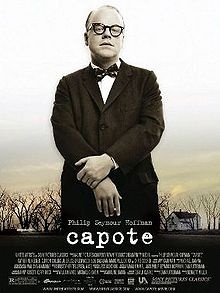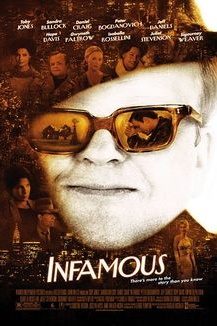Washburn UniversityCenter for Kansas Studies

Capote & Infamous
Article Written by: Philip Heldrich, University of Washington, Tacoma
*Article used with permission from the Kansas Historical Society*
Coincident with the forty-year anniversary of the publication of Truman Capote’s In Cold Blood in 1966, two films, Capote (2005) and Infamous (2006), present new examinations of the brutal Clutter killings in rural Kansas and Capote’s obsession with them. Unlike the critically acclaimed fi lm adaptation of In Cold Blood (1967), directed by Richard Brooks and starring Robert Blake as Perry Smith (a role that now seems somewhat ironic given Blake’s own real-life trial for murder), Capote and Infamous focus less on the killers and more on Capote’s fascination and fixation with the murders and the trial. These films suggest Capote’s compulsion ruined his life. While both films treat a common subject, they present slightly different fictionalized versions that arrive at the same conclusion. To one degree or another, both films present a Capote who crossed the line between self and subject, fell in love with murderer Perry Smith, and suffered conflicted feeling over the capital punishment that ended the killers’ lives and provided an ending to his book. In both films, Kansas itself becomes a symbolic repository for conservative, middle-class America in the late 1950s and early 1960s, a place that stood in stark contrast to the decadence of a boozy, high-society New York City in which a lauded Capote made his life. The place of Kansas in these films comes across as true to Capote’s own symbolic use of the state in his book. Kansas, where the supposedly good citizens and values of the nation reside, the symbolic heartland, is no place for random murders, Capote’s non-fi ction novel and both of these fi lms suggest. When brutal crimes take place in Kansas, it injures us all, leaving us with no place beyond reproach on which to project our necessary idealism.
Of the two films, Capote (2005), directed by Bennett Miller from a screenplay by Dan Futterman, presents the more successful cinematic exploration of Capote. Philip Seymour Hoffman, who won a Best Actor Oscar for his portrayal of Capote, gives a strong performance as the eccentric, gay southern writer. Hoffman—whose credits include Cold Mountain (2003), Magnolia (1999), and Almost Famous (2000), another fi lm in which Kansas has an important symbolic role—plays Capote as an intelligent, witty writer whose life is transformed through his writing about the killers. He turns from a gregarious socialite to a detached depressive. With a pensive piano score by Mychael Danna and the film’s numerous, uncomfortable pauses, Capote foreshadows the depression that would come to defi ne the author’s later years. With a much slower pace, Capote (2005) stands in stark contrast to Brooks’s In Cold Blood (1967), with its frequent jump cuts, menacing jazz score by Quincy Jones, and emphasis on the killers and their violent crimes.
The actual place of “Kansas” in Capote (2005) is constructed out of a bit of movie magic. Both the Clutter home and the initial establishing shots were actually filmed in and around Winnipeg, Canada. The very emptiness of “Kansas,” figured in the fi lm’s opening of wind blown wheat, eventually becomes the emptiness from which Capote will suffer. Kansas in the fi lm seems best represented through the figure of KBI lawman Alvin Dewey (Chris Cooper). Dewey embodies the law and order presumed to exist in Kansas before the murders. Summarizing this idea, Capote admits: “Two worlds exist in this country, the quiet conservative life and the life of these two men, the underbelly, the criminally violent, and those worlds converged that bloody night.” How this convergence shattered the myth of the heartland constitutes the fi lm’s central theme. Such an epiphany would, the fi lm suggests, destroy Capote as well. “Researching this work has changed my life. It has altered my point of view about almost everything,” the writer tells us in the film. Capote’s relationship with Perry Smith, the tragic confl ict between his feelings for the killer and the need to acknowledge Smith’s terrible crime, further compromises his sanity. Ultimately, director Miller presents an effective tragic paradox in Capote, exploring the author’s torn feelings over his taboo love of Smith that stand in conflict with his desire to fi nd a proper ending to his book, where the killers must die for their crimes.
Infamous (2006), written and directed by Douglas McGrath, presents a less successful version of the same tragedy despite the box-office promise of its A-list stars, including Sandra Bullock, Sigourney Weaver, Gwyneth Paltrow, and Isabella Rossellini. The film fails not at the level of acting but in its direction, where the form, at one point a series of testimonials about Capote from his social circle, never fully realizes the filmmaker’s intentions. Toby Jones presents a decidedly more flamboyant and overtly gay Capote than Hoffman, going so far as to intimately kiss Perry Smith in one scene. At times, the film has an almost whimsical feel despite its dire subject matter.
As in Capote (2005), Infamous (2006) makes good use of the lifelong friendship between Capote and Nelle Harper Lee (Sandra Bullock in Infamous; Catherine Keener in Capote), author of the Pulitzer Prize-winning To Kill a Mockingbird (1961). Both films show how Lee played an instrumental role in helping the eccentric, gay Capote gain acceptance among Kansans and secure access to the killers. However, Infamous plays down any jealousy between the writers, a theme to which Capote alludes. Another major difference between these films is in their representations of Capote as a gay man. His homosexuality figures more prominently and openly in Infamous, which seems at times more about a taboo love never realized than about the murders, although the two are intertwined.
The place of “Kansas” in Infamous seems somewhat similar to its role in Capote, although it is presented with less cinematic appeal and symbolic importance in the later film. While cinematographer Adam Kimmel makes good use of “Kansas” to emphasize Capote’s ideas, Bruno Delbonnel’s cinematographic view of “Kansas” has less of a place in Infamous. Kansas as metaphor, however, figures prominently in Infamous, as in the message delivered by a Holcomb rancher: “What scares me is sometimes out of nowhere a bad wind blows up . . . and despite the weight that’s holding you to the ground, when that wind comes, it picks you up light as a leaf and takes you where it wants. We’re in control till we’re not, then we’re helpless.” It seems no contemporary film about the state, acknowledging the anxiety of influence, can be without a proper wind reference.
It is also worth mentioning here the very different portrayals of the murderer, Perry Smith: by Clifton Collins, Jr. in Capote, and in Infamous by Daniel Craig, who became the newest James Bond in Casino Royale (2006). Collins presents a more brooding Smith, while Craig gives him a more violent edge. Both provide competent portrayals of an abandoned son whose parents were divorced alcoholics and whose mother was suicidal, although Craig’s violent Smith, also portrayed as a wannabe country-western singer in Infamous, seems somewhat more complex, novel, and haunting. Both portrayals recall the brilliant, edgy performance of Robert Blake, which neither Collins nor Craig comes near, although all three actors bring to the screen the menacing nature of a complex killer, part violent psychopath and part misunderstood artist.
While the cinematic appeal of the stories of In Cold Blood and Truman Capote’s tragic life might seem somewhat exhausted now, Capote’s book will continue to be read for its masterful treatment of its subject and its role in the creation of the nonfiction novel. Capote (2005) will be admired for its cinematic complexity and solid acting performances, while Infamous (2006), a weaker adaptation, may not withstand the test of time. The place of Kansas, however, will always have a necessary symbolic role in any treatment of the book. The random nature of these brutal crimes violated the myth of the heartland. In the very compromising of this myth, these works suggest, everybody seems to have lost something, to have become victimized. Such is the tragedy that Capote understood and effectively conveyed; the revelation may have destroyed him, but it will always be remembered.
Philip Heldrich
University of Washington, Tacoma


